State-dependent and -independent effects of dialyzing excitatory neuromodulator receptor antagonists into the ventral respiratory column
- PMID: 27687562
- PMCID: PMC5504392
- DOI: 10.1152/japplphysiol.00619.2016
State-dependent and -independent effects of dialyzing excitatory neuromodulator receptor antagonists into the ventral respiratory column
Abstract
Unilateral dialysis of the broad-spectrum muscarinic receptor antagonist atropine (50 mM) into the ventral respiratory column [(VRC) including the pre-Bötzinger complex region] of awake goats increased pulmonary ventilation (V̇i) and breathing frequency (f), conceivably due to local compensatory increases in serotonin (5-HT) and substance P (SP) measured in effluent mock cerebral spinal fluid (mCSF). In contrast, unilateral dialysis of a triple cocktail of antagonists to muscarinic (atropine; 5 mM), neurokinin-1, and 5-HT receptors does not alter V̇i or f, but increases local SP. Herein, we tested hypotheses that 1) local compensatory 5-HT and SP responses to 50 mM atropine dialyzed into the VRC of goats will not differ between anesthetized and awake states; and 2) bilateral dialysis of the triple cocktail of antagonists into the VRC of awake goats will not alter V̇i or f, but will increase local excitatory neuromodulators. Through microtubules implanted into the VRC of goats, probes were inserted to dialyze mCSF alone (time control), 50 mM atropine, or the triple cocktail of antagonists. We found 1) equivalent increases in local 5-HT and SP with 50 mM atropine dialysis during wakefulness compared with isoflurane anesthesia, but V̇i and f only increased while awake; and 2) dialyses of the triple cocktail of antagonists increased V̇i, f, 5-HT, and SP (<0.05) during both day and night studies. We conclude that the mechanisms governing local neuromodulator levels are state independent, and that bilateral excitatory receptor blockade elicits an increase in breathing, presumably due to a local, (over)compensatory neuromodulator response.NEW & NOTEWORTHY The two major findings are as follows: 1) during unilateral dialysis of 50 mM atropine into the ventral respiratory column to block excitatory muscarinic receptor activity, a compensatory increase in other neuromodulators was state independent, but the ventilatory response appears to be state dependent; and 2) the hypothesis that absence of decreased V̇i and f during unilateral dialysis of excitatory receptor antagonists was due to compensation by the contralateral VRC was not supported by findings herein.
Keywords: breathing; neuromodulation; pre-Bötzinger complex; sleep; ventral respiratory column.
Copyright © 2017 the American Physiological Society.
Figures

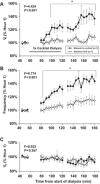
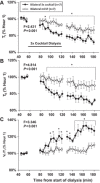


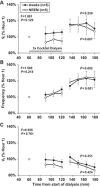
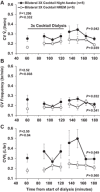
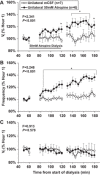


Similar articles
-
Ventilation and neurochemical changes during µ-opioid receptor activation or blockade of excitatory receptors in the hypoglossal motor nucleus of goats.J Appl Physiol (1985). 2017 Dec 1;123(6):1532-1544. doi: 10.1152/japplphysiol.00592.2017. Epub 2017 Aug 24. J Appl Physiol (1985). 2017. PMID: 28839004 Free PMC article.
-
Atropine microdialysis within or near the pre-Botzinger Complex increases breathing frequency more during wakefulness than during NREM sleep.J Appl Physiol (1985). 2013 Mar 1;114(5):694-704. doi: 10.1152/japplphysiol.00634.2012. Epub 2012 Dec 27. J Appl Physiol (1985). 2013. PMID: 23271698 Free PMC article.
-
Combined unilateral blockade of cholinergic, peptidergic, and serotonergic receptors in the ventral respiratory column does not affect breathing in awake or sleeping goats.J Appl Physiol (1985). 2015 Aug 1;119(3):308-20. doi: 10.1152/japplphysiol.00145.2015. Epub 2015 May 28. J Appl Physiol (1985). 2015. PMID: 26023224 Free PMC article.
-
Julius H. Comroe Distinguished Lecture: Interdependence of neuromodulators in the control of breathing.J Appl Physiol (1985). 2018 Nov 1;125(5):1511-1525. doi: 10.1152/japplphysiol.00477.2018. Epub 2018 Aug 23. J Appl Physiol (1985). 2018. PMID: 30138081 Free PMC article. Review.
-
Pharmacologically Induced Ventilatory Depression in the Postoperative Patient: A Sleep-Wake State-Dependent Perspective.Anesth Analg. 2021 May 1;132(5):1274-1286. doi: 10.1213/ANE.0000000000005370. Anesth Analg. 2021. PMID: 33857969 Review.
Cited by
-
Galaninergic and hypercapnia-activated neuronal projections to the ventral respiratory column.Brain Struct Funct. 2024 Jun;229(5):1121-1142. doi: 10.1007/s00429-024-02782-8. Epub 2024 Apr 5. Brain Struct Funct. 2024. PMID: 38578351 Free PMC article.
-
Physiological and neurochemical adaptations following abrupt termination of chronic hypercapnia in goats.J Appl Physiol (1985). 2021 Apr 1;130(4):1259-1273. doi: 10.1152/japplphysiol.00909.2020. Epub 2021 Feb 4. J Appl Physiol (1985). 2021. PMID: 33539265 Free PMC article.
-
Neuronal mechanisms underlying opioid-induced respiratory depression: our current understanding.J Neurophysiol. 2021 May 1;125(5):1899-1919. doi: 10.1152/jn.00017.2021. Epub 2021 Apr 7. J Neurophysiol. 2021. PMID: 33826874 Free PMC article. Review.
-
Presynaptic Mechanisms and KCNQ Potassium Channels Modulate Opioid Depression of Respiratory Drive.Front Physiol. 2019 Nov 22;10:1407. doi: 10.3389/fphys.2019.01407. eCollection 2019. Front Physiol. 2019. PMID: 31824331 Free PMC article.
-
Effects on breathing of agonists to μ-opioid or GABAA receptors dialyzed into the ventral respiratory column of awake and sleeping goats.Respir Physiol Neurobiol. 2017 May;239:10-25. doi: 10.1016/j.resp.2017.01.007. Epub 2017 Jan 27. Respir Physiol Neurobiol. 2017. PMID: 28137700 Free PMC article.
References
MeSH terms
Substances
Grants and funding
LinkOut - more resources
Full Text Sources
Other Literature Sources
Research Materials

